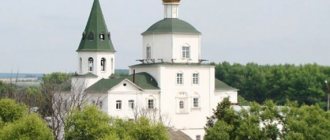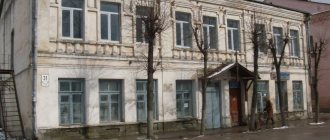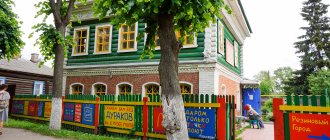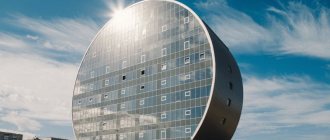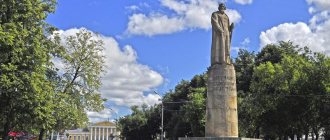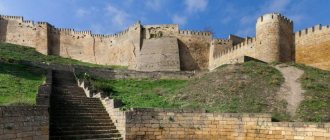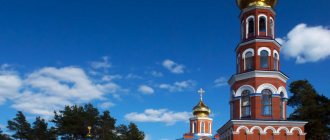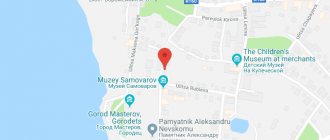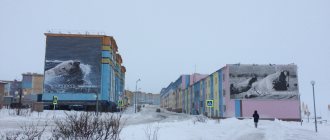Marks is a city in the Saratov region, a regional center. It is located on the left bank of the Volga, 60 km from the regional center.
It is connected with Saratov and nearby cities by a developed bus network. There is no railway in this part of the Volga region, there is a cargo port on the river, and there is no passenger water service.
About the city of Marks
Marx was founded as a German colony and the exact date of its creation still raises questions among historians. The official date is August 27, 1766, but there are versions about 1764 and 65.
A new German colony was created by the Belgian baron Frederic Beauregard de Cano, who invited compatriots to the fertile Saratov lands. The colony became baronial, then German settlements were divided into provocative ones, where residents paid taxes in favor of these entrepreneurs, and crown ones.
The baron's residence was created here. The colony received the name in honor of the Empress, Catherinenstadt.
In total, during the period of active attraction of immigrants from Europe, 106 colonies were created, where 6,174 families lived, or 23,404. The future Marx was built on the left bank of the Volga, then called the Meadow Side.
The colony became the largest of the newly created ones; military engineer Ivan Rice is considered its founder. He was engaged in both cartography of the area and the construction of the settlement. The problem for the new point on the map was the constant attacks of nomads who captured men and took them to China.
There is a known correspondence between the headman of Ekaterinenstadt and the empress, in which he asked to reduce fees, since most of the payers were captured.
Gradually the colony grew stronger, surrounded its borders with walls, and then the raids stopped. Accelerated economic development began. Actively received and transshipped cargo, mainly bread, pier.
Warehouses, barns, and mills appeared. American cigar tobacco became a serious factor in Ekaterinenstadt's trade balance; the district quickly became the center for the cultivation of this crop in the Volga region, confidently occupying second place in its production in the Russian Empire.
In addition to tobacco, such an unusual spicy crop as anise was grown in the area. There was a leather tanning factory.
Education developed; in 1832, the Russian Central School was opened here, the first among all German colonies in Russia. In 1848-51, a monument to Catherine the Second was unveiled, funds for which were collected by the entire village.
It was surrounded by a garden. We collected more than 14 thousand silver rubles. The monument was destroyed after the revolution. During the period of active development, at the end of the 19th century, workshops for the production of agricultural machinery were built here.
Marx
Historical reference
Already during the Bronze Age, people actively inhabited these regions.
Until now, road workers, builders and farmers still come across its parking lots in the outskirts of the city. In the early Middle Ages, a very important trade route passed here - the “Silver Road”, which connected Volga Bulgaria and Kievan Rus with Persia and India. Later, this important transport artery received another name - “Ardapazar Road”. However, the left bank of the Volga was a wild and uninhabited region for a long time, until Empress Catherine II decided to populate the outskirts of her empire with foreigners. In July 1763, a Manifesto was issued, which invited foreigners to settle in Russia. In June 1765, 83 families from France, Saxony and Hesse-Darmstadt founded a settlement, to which the summoner Baron F. Beauregard de Cano gave the name Ekaterinenstadt (in Russian documents the settlement received a simplified Russian-language form - Baronsk). The design and construction of the city was led by Captain I. Rice, as well as Lieutenant O. Monjou. Residents of the colony were engaged in agriculture (wheat, rye, potatoes, tobacco, melons), crafts (making smoking pipes and straw weaving), and gardening (“Baron’s anise”).
In the first half of the 19th century, thanks to the grain trade, Ekaterinenstadt began to resemble a county town. Catholic (1828) and Lutheran (1843) churches were built, and a Russian school was opened (1834). Contemporaries noted the cleanliness and neatness of the colony. In 1851, at the expense of the colonists, a monument to Catherine II, created by the famous sculptor P.K., was erected in Ekaterinenstadt. Klodt.
According to the Central Statistical Committee for 1859, the German colony of Ekaterinenstadt had 3 churches (Lutheran, Catholic and Orthodox), a school, a bazaar, five factories, and a pier. In the second half of the 19th century, the Russian Central School (1858), the Neuberg eye clinic (1879), the Schaeffer brothers' workshops (1880) were opened in Ekaterinenstadt, and a new Orthodox church was built (1874).
In 1910, the residents of Ekaterinenstadt owned 38,352 dessiatines of land, of which 24,543 dessiatines were allotments and 13,809 were purchased (29 dessiatines for each yard). In the colony itself there were 3 churches, 11 educational institutions (including a men's gymnasium, a women's gymnasium, the Russian Central School, 3 zemstvo, 3 parochial schools, a private school and a zemstvo elementary school). The population was served by one zemstvo doctor, 3 private ones, a zemstvo hospital, there were 3 public meetings, a notary, a postal and telegraph office, and a telephone. In addition, there was police supervision, one district zemstvo commander, two judicial investigation stations and one conscription station. Also in Ekaterinenstadt there were mills, a weaving factory and 9 factories.
After the October Revolution on March 3, 1918, Soviet power was established in the city. On April 4, 1918, the village officially received city status.
On August 15, 1918, Ekaterinenstadt became a district center, and on October 19, the administrative center of the Labor Commune of Volga Germans (until August 1, 1921). In May 1919 the city was renamed Marxstadt.
The city of Marks is the birthplace of Soviet tractor and engine manufacturing. In the spring of 1924, the first Soviet tractor “Karlik”, designed by the inventor Y. Mamin, came out of the local gates. Since 1923, the same plant began producing oil engines.
In 1926, the city housed a central workers' cooperative, an agricultural cooperative partnership, seven primary schools, a seven-year school, educational centers, libraries, a museum, three vocational schools, an agricultural school, a pedagogical school, a music school, a College of Agricultural Mechanization, a College of Soviet Trade, a power plant, machine-building (now JSC Volgodieselapparat), brick factory, shag factory, collective farm and state farm theater, puppet theater and MTS.
In 1941-45. thousands of Marxists took part in the Great Patriotic War. Many were awarded orders and medals. The deportation of the Volga Germans (1941) dealt a serious blow to the further development of the city, the population of which decreased fivefold. By the decree of the Presidium of the Supreme Council of the RSFSR “On the renaming of some districts and cities of the Saratov region”, on May 19, 1942, the city of Marxstadt was renamed the city of Marx .
On January 12, 1965, by Decree of the Presidium of the Supreme Soviet of the RSFSR, Marx became a city of regional subordination. The revival of the city began in the second half of the 60s. last century, when the May Plenum of the CPSU Central Committee in 1966 decided on the reclamation of dry lands in the Volga region. SSPTU No. 9, SGPTU No. 18, GPTU No. 46, Medical and Music schools were opened in Marx. In addition, the city built the Kristall Cultural and Cultural Complex, the K. Marx Cultural Center, as well as other social and cultural service facilities for the population. The transport and industrial base of the city has improved, which has been replenished with beer, a bakery, a river port, a butter factory, an electrical products plant, an air terminal, the Marksvodstroy reclamation trust and a reinforced concrete products plant.
The modern city of Marks is a dynamically developing city with medium and small businesses. In recent years, it has noticeably transformed, while managing not only to preserve, but also to restore its historical identity, the cleanliness and comfort of its streets, avenues, squares, its unique style and unique architectural appearance. In recent years, new facilities have been built in Marks, giving our city a more modern look and beautifying it. This, created at the expense of residents of the city and region, is a beautiful architectural ensemble, which includes a monument to Catherine II (restored), a park named after her with fountains and the Alley of Heroes with bronze busts of fellow countrymen. Thanks to this ensemble the city became recognizable.
Marx coat of arms
An early heraldic description of the coat of arms of the Marksovsky district says that in a green shield between two ears of corn there is a flying wild goose above the waves, carrying in its beak the plant “woad” (since the early Middle Ages it has been a raw material for the production of blue paint).
In the free part is the coat of arms of Saratov. Green color means expanses of cultivated fields and meadows and forests along the Volga and Maly Karaman rivers. The ears symbolize agriculture; the fact that they grow from the waves indicates that reclamation lands are spread around the city.
In the modern version of the coat of arms, approved in 1998, the ears of corn disappeared and the woad stem became silver with golden flowers. It is interesting that military mercenaries were called wild geese, and an armed red goose can become a unique reminder of the difficult history of the area.
But it is interesting that in 2012 the Marks coat of arms changed again. Now it depicts in a scarlet (red) field above an azure (blue), thinly bordered with silver, wavy tip (water surface) - the golden crowned monogram of Empress Catherine the Second.
Population of Marx
As of 2021, more than 30 thousand people lived in the city. This is 485th place out of 1113 cities in Russia. Interestingly, since 1989 the city's population has remained within these limits, without declining, which differs from general demographic trends. The national composition is different, more than 80% are Russian.
At the time of its founding, citizens of various nationalities lived here, in 1910 more than 95% were Germans, and three denominations, Catholics, Lutherans and Orthodox. After the deportation of the Germans, by 1959 a large Tatar community had been created here.
The economy of the region is based on agriculture, but the production volumes that were observed during the period of state farms and the USSR no longer exist. Peasant farms are actively working.
Known in the field of beer, created in pre-revolutionary times, the hops for it are grown in the surrounding fields.
Many villagers live in wooden houses built by German colonists, and they are still livable. It operates successfully producing agricultural machinery.
Services sector
The situation with entrepreneurial activity in the field of services to the population in the city leaves much to be desired, but despite this, a slow increase in the number of entrepreneurs is observed in Marx. According to statistics from the Pension Fund of the Russian Federation, in the city of Marks there are only 2,500 thousand entrepreneurs for 32 thousand residents, which is extremely small to provide citizens with quality goods and services. The quality of the service sector is low and caters primarily to low purchasing power. The service sector in the city is poorly represented and, due to the small number of residents, as well as the low purchasing power of citizens, is practically not developed:
- There are small local restaurants and a few bars; the Fast Food and delivery food services sector is practically absent. Due to the small market, there are no international restaurants and coffee shops in the city. There are no food services for children.
- Healthcare services are very poorly represented, which forces city residents to use the services of private clinics in large, nearby cities: Engels and Saratov. There are several local pharmacies and dental clinics.
- There is currently no laundromat in the city.
- There are also no sports services in the city: fitness clubs, swimming pools, gyms...
- The city's hotel sector is represented by low-budget roadside hotels (motels) and is aimed at the casual tourist market. There are no middle and upper class hotels designed for city guests, which cannot be said about the region: almost the entire eastern coastal part of the Marksovsky district to the borders of the Balakovo district is represented by numerous summer camp sites for the middle class with good quality service.
- The market for private transportation and private taxis is experiencing the most rapid development in the city.
- There are several Soviet-era hairdressing salons and new beauty studios, mainly aimed at the budget economy class segment.
Marx's education and culture
The Volozhka newspaper, which also has an Internet portal, informs citizens about the events of the city. There is also local television here, preparing information and entertainment programs.
The local history museum is extremely interesting, where one of the most interesting exhibitions in the country is presented, related to the history of the Volga Germans.
The agricultural technical school, polytechnic lyceum, and electrical engineering college are responsible for education. There are children's art and music schools. The secondary medical school and the art school train personnel for healthcare and culture.
There is a stadium, the Central House of Culture and the Youth Children's Art House. A Center for National Cultures has also been created.
See also: Districts of the Saratov region
Streets and landmarks of Marx
You can take a walk in Marks in the old but well-maintained Catherine Park. Not far from it there is a monument to Catherine the Second, restored in 2007 with funds from Germans living abroad.
It is located on Lenin Avenue, formerly called Stepnaya Street. The avenue is decorated with lanterns and trees; many houses of ancient architecture have been preserved on it. Nearby is the Walk of Fame with busts of WWII heroes.
The Church of the Apostle Andrew the First-Called has been preserved in the city; for representatives of other faiths there is the Evangelical Lutheran Church of the Holy Trinity, and the Catholic Church of Christ the King.
The Catholic church of unique architecture, more reminiscent of a monument to the 1980 Olympics, was opened in 1993. This is the first Catholic church built in Russia after the revolution. There is an organ brought from the German city of Nassau. A mosque was built for a small number of the Tatar population.
The city is landscaped, the main work was carried out in 2010, for the arrival of President D. Medvedev. Most old German houses have plaques with the names of their original owners.
Marx Historic Sites
Going for new stories
Many major tourist sites are well known not only in their own country, but also abroad. Millions of people come to them every year. However, the city also has many places that are less popular, although no less interesting. Recently, excursions to such objects have begun to be in demand.
Travel agencies on our website are ready to offer you a non-standard rendezvous to well-known attractions. There are many advantages of ordering such a tour:
- Not all buildings are easy to find information about, especially if you don’t know about their existence;
- experienced guides will be able to take you to the most interesting and little-known places quickly and with maximum benefit - you won’t take extra steps and won’t get tired so quickly;
- If you need to cover a long distance to the next object, you will travel on a comfortable bus from a travel agency.
A professional guide will lay out the route with ingenious precision, help you get your bearings and tell you such juicy details about the object that even grandmothers on the benches will be forced to admit defeat.
Interesting historical places of Marx keep many secrets. You can have a good time listening to such stories, most of which are quite exciting. Particularly interesting are the mystical stories about the construction of the house and its famous inhabitants.
If you prefer to spend interesting leisure time with friends, looking for places associated with specific events, real or fictitious, you should contact travel agencies on our website. Professionals will organize for you a trip to places from books, in which the action takes place on the streets, in houses, shops, cafes and parks that actually exist. You can also take a tour to places associated with historical figures or events.
Active leisure in the city
Various thematic events, especially those based on the same books, are a good way to learn about your city and its history. Participants are given a specific task that needs to be completed, and for this they need to know some of Marx’s cultural places. Anyone can participate in such an event by contacting the guides on our website. You will be offered sporting events where you will need to find an object and bring it to the finish line faster than others or collect puzzle pieces hidden in historical places.
Professionals also conduct quests with riddles, in which you must first understand what historical or cultural object we are talking about in order to find the desired item. This is a great way to actively spend time with your family, friends, and colleagues. Travel agencies offer many options for conducting such games to make it fun and interesting for everyone. In addition, their rates are very flexible.
Every city has places that are a must-see for any tourist. But, besides them, there are historical places in Marx that are worth visiting in order to study the heritage of past eras, deepen your knowledge of history and your city. They're not well known, so being around them means you won't have to wait in line for a photo or worry about someone ruining your shot. Among these objects there are really interesting and unique ones, and the site’s guides are ready to show them to you. Walking and listening to stories about all the buildings around you is a great opportunity to have a good time in warm company.
Neighborhood of Marx
Traveling outside the city will bring new discoveries. The high banks of the Volga invite you to relax and enjoy fishing.
Nearby are the popular Zhiguli Mountains, which contain many secrets, and residents of the regional center are actively developing the area for the purpose of dacha construction.
A visit to Marx will open new pages in the history of the settlement of the Saratov region, its culture and economy, and a walk through the Zhiguli Mountains will reveal the secrets of nature.
Official website of the administration of the Marksovsky district of the Saratov region. Website of the municipality of the city of Marks

